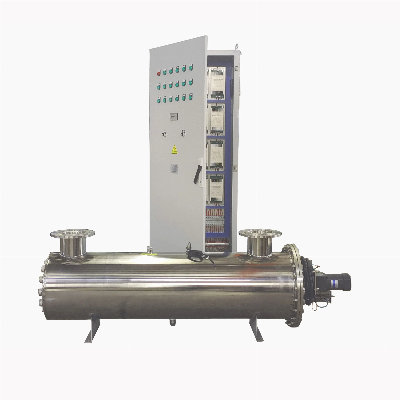300m3/h Industrial UV Water Steriliser to discharge of Wastewater
treatment Introduction Ultraviolet light treatment is a
widely recognized and proven method of disinfection of water and
has several advantage over other disinfection methods such as
chlorination, ozonation, etc.UV light does not add anything to the
water ,such as ,undesirable color ,odor , taste , or flavor ,nor
does it generate harmful byproducts. It adds only energy in the UV
radiation. Also, UV disinfection requires only a fraction of the
contact times required by other disinfection methods. It is fast,
efficient, effective, economical and environmentally-friendly.
Exploitation conditions1, Water temperature: 5ºC~50ºC; Use
ambient temperature: - 5ºC~50ºC; Surroundings relative
temperature:< 93% (while temperature is 25ºC)2, Voltage:
Direct current 110V-240/50HZ/60Hz.3, Cultivation water: After
filtration or other processing filtration freshwater, seawater4, if
the water need to be processed but the quality cannot meet the
above requirements, should be process in advance, such as
flucculation,sedimentation,filtration. Superiorities:1,
high efficient sterilization: bacterias could be killed within one
or two seconds,and the sterilization rate could reach
99%-99.9%2, broad-spectrum of UV disinfection is the
highest,it could kill almost all bacteria efficiently.3, The
self-cleaning UV sterilizer does not have two pollution: The
ultraviolet ray sterilization does not join any chemical agent,
therefore it not has two pollution to the water body and the
environment. Does not change in the water any ingredient.4,
Self-cleaning UV sterilizer works security, reliable: The
traditional disinfection technologies such as chlorine or ozone
,the disinfection itself is part of flammable substance.and the
Self-cleaning UV sterilizer is the opposite. 5,low maintenance
cost, small occupying area, the structure is simple,
therefore the total investment lower.i t is lower in running cost,
in thousand ton water treatment quantity capacity, its cost is only
the chlorine disinfection 1/2.Features:Explosion-proofFixed time
cleans the quartz drive pipe automatically;Adopting the hard glass
ultraviolet lamp, the best effect would be achievedThe light
alarmMade up by many kinds of output device, including the light
emitter diode and the counter,Composed the precise nanometer
ultraviolet ray monitoring meter304 or 316 polished stainless steel
reactor Solenoid valve and remote control system, including
infrared output device;Pure equipment, galvanization polished, uses
in highly purified environment;Appliance and equipment
configuration applies to all over the world market.Appearance
design,easier to useHow Does UV Sterilisation Work?
Ultraviolet ray according to its biology function difference,
ultraviolet ray sterilizer would devide to UV-A(320-400nm),
UV-B(275-320nm), UV-C(200-275nm) and vacuum ultraviolet ray.in
fact, water treatment take advantage of UV-C,In the vicinityof the
in-band 260nmhas provedto be the most efficient.Guan Yu Uv
sterilizer optics, microbiology, machinery, chemistry, electron,
hydromechanics as a whole.Uses the special designed the high
efficiency,High strength and the long life of UV-C generator
produces intense UV-C irration of flowing water.When in after the
water bacterium and so on receives certain dosage ultraviolet ray
disinfestor the ultraviolet UV-C light (wave length 253.7nm) to
shine,Her cell DNA and the structure are destroyed, the cell
regeneration is unable to breed, thus get the water the
disinfection and the purification.Organic molecules will be
decomposed by the 185 wavelength of spectrum,producing the hydrogen
free-radical and oxidation of organic compounds inWater molecules
to carbon dioxide .achive the purpose of removing the TOCWhat
Contaminants Do UV Sterilizers Remove? There are no
micro-organisms known to be resistant to UV, unlike chlorination.
UV is known to be highly effective against bacteria, viruses,
algae, molds and yeasts, and disease causing oocysts like
cryptosporidium and giardia. In practice, bacteria and viruses are
the cause of most major waterborne pathogenic diseases. Of these
enteric viruses, hepatitis virus and Legionella pneumophila have
been shown to survive for considerable periods in the presence of
chlorine, but are readily eliminated by UV treatment. For most
microorganisms, the removal efficiency of UV for microbiological
contaminants such as bacteria and virus generally exceeds
99.99%.
CONVENTIONAL METHODS OF WATER TREATING CHLORINEOZONEULTRA VIOLETCapital costLowestHighLowEase of installationGoodPoorExcellentEase of MaintenanceGoodPoorExcellentCost of MaintenanceMediumHighLowestOperating CostLowHighLowFrequency Of MaintenanceFrequentContinuousV. InfrequentControl SystemPoorGoodExcellentVirucidal EffectGoodPoorGoodToxic ChemicalYesYesNoResidual Effect Problem withYesYesNoHazardsHighYesLow to noneContact Time30 - 60 minutesHigh1 - 5secondsDisinfection PerformanceLeaves some pathog
Related products about 300m3/H Industrial UV Water Steriliser to Discharge of Wastewater Treatment
-
 Waste Tyre Plastic Recycling Machinery Machine Tire Crusher Production Line Rubber Crumb Grinding Machine Equipment Tire Shredder
Waste Tyre Plastic Recycling Machinery Machine Tire Crusher Production Line Rubber Crumb Grinding Machine Equipment Tire Shredder
-
 Stretch Plastic Blowing Pet Bottle Making Blow Molding Machine Bottles Stretch Automatic Pet Bottle Blowing Machine
Stretch Plastic Blowing Pet Bottle Making Blow Molding Machine Bottles Stretch Automatic Pet Bottle Blowing Machine
-
 Waste Plastic Pet Bottle, Water Bottle Flake, PP/HDPE/LDPE PE Film Jumbo Woven Bags Plastic Crusher Machine, Plastic Crushing Washing Recycling Machine
Waste Plastic Pet Bottle, Water Bottle Flake, PP/HDPE/LDPE PE Film Jumbo Woven Bags Plastic Crusher Machine, Plastic Crushing Washing Recycling Machine
-
 Type 2 Wall-Mounted Electric Car Charging Station 7kw /11 Kwelectric Vehicle Charging Station Home Wallbox AC EV Charger Single Phase or 3three Phase
Type 2 Wall-Mounted Electric Car Charging Station 7kw /11 Kwelectric Vehicle Charging Station Home Wallbox AC EV Charger Single Phase or 3three Phase
-
 G-View G12W Wholesale Auto Car LED Headlight Bulb High Power H13 H11 9005 H7 H4 Car LED Headlights LED Car Lights
G-View G12W Wholesale Auto Car LED Headlight Bulb High Power H13 H11 9005 H7 H4 Car LED Headlights LED Car Lights
-
 New Design Porcelain Round Plates Dinner Set for Wedding and Banquet
New Design Porcelain Round Plates Dinner Set for Wedding and Banquet
-
 China 2023 New Design Super Soft 100% Polyester Microfiber Knitted Oversized Decoration Hoodie Blanket
China 2023 New Design Super Soft 100% Polyester Microfiber Knitted Oversized Decoration Hoodie Blanket
-
 Handmade Art Creative Materials Thickened White Paper Cup DIY Disposable Handmade Colored Paper Cup
Handmade Art Creative Materials Thickened White Paper Cup DIY Disposable Handmade Colored Paper Cup



